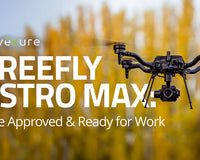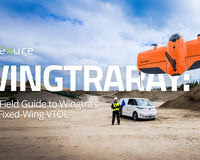Are you flying the DJI M300 RTK drone?
If so, you know you’ve got a powerful UAS with many payload options.
In fact, you can mount up to three payloads at once (max weight 5.95 lbs.), allowing you to configure the M300 to take on any project.
So, let’s talk about the Zenmuse H20 Series.
The H20, DJI’s first hybrid sensor solution, provides you with an ideal optics system for inspections, mapping, security, and photography.
The Zenmuse camera series includes multiple similarities between each model, while still offering variations that meet specific industry needs… which leads us to the H20T and the H20N.
H20, H20T, H20N… “What’s the difference?” you wonder.
Well, the major difference is the T/N designation at the end. It’s a small notation to be sure, but it makes a major difference in both function and cost.
It starts with the base model: the H20.
While an outstanding piece of optics to be sure, Zenmuse took their camera to the next level with the H20T and H20N.
That “T” in H20T designates thermal capabilities, while the “N” in H20N indicates night vision ability.
When the original H20, released in May 2020, it cost just over $3,600.
Yet, the H20T ($11,209) and the H20N ($12,999) are significantly more.
Clearly, each provides a substantial upgrade over the H20 for specific use-cases.
But, in what ways?
You know you need one or the other, but can’t afford both.
Which one works better for your specific missions?
Well, recently, we sent the H20N and H20T into the sky to compare them to one another.
In this article, we’ll break it all down, and show you side-by-side optics of both so you can make the right decision for your UAS program.
Physical Comparison
First, it’s important to know the design of these cameras is very similar, with the H20N coming in just slightly larger and heavier than the H20T.
The H20N weighs in at 1.94 lbs. - only slightly heavier than its thermal counterpart. And, with dimensions of 7 x 5.3 x 6.3 in., it’s only fractionally larger, with the H20T measuring 6.6 x 5.3 x 6.3 in.

So regardless of your mission, the size of these two cameras won’t make much of a difference.
Whichever one you choose, your flight duration, airspeed, maneuverability will be nearly identical.
You’ll also appreciate the fact that both systems are IP44 rated, have an operating temperature of -4°F to 122°F, roughly the same endurance, and support a MicroSD card (Max capacity: 128 GB, UHS-1 Speed Grade 3 required) for maximum storage capacity.
Given these parallels, know that you aren’t sacrificing physical abilities by choosing one over the other.
It’s really a question of which visual data you need from your cameras.
Zenmuse H20 Cameras Side-By-Side
Though several features on these cameras are identical, a few variations make each a little more suited for specific missions.
Both payloads are equipped with a laser range finder that can detect ranges accurately between 9.84 ft. and 3937 ft.
But, for daylight operations, the H20T gets the slight nod.
For example, the zoom camera on the H20N offers a 1/1.8" CMOS sensor, 4MP, 20X Hybrid Zoom with 128X Max Zoom.
The H20T, on the other hand, includes a 1/1.7" CMOS sensor, 20MP, 23X Hybrid Zoom with 200X Max Zoom.
In short, the H20T version is going to provide you far better zoom capabilities. At least, in the daylight.
It’s also important to note that because the H20N was designed to capture as much light as possible (for low-light/night imaging), the pixel size is increased. But, that means the overall pixel count was reduced.

*The image above shows the H20N thermal camera zoom at 32x (left) and the zoom camera at 32x (right)
Thus, details and clarity are lost when compared to the H20T version.
So, if your missions take place primarily during the day, you’ll want to go with the H20T.
For thermal imaging, each payload brings something to the table.
Both have a 640×512 px Radiometric Thermal Camera, yet the H20N has two cameras, one for wide-angle, and one for zoom.
At 16X zoom, it offers greater ability than the H20T's 8X. It also improves image clarity.

*The picture above shows the Zenmuse H20T IR zoom at 8x (left) and zoom camera at 80x (right)
The wide-angle camera on the H20N has a 1/2.7" CMOS sensor at 2MP, while the H20T's wide angle camera is equipped with a 1/2.3" CMOS sensor at 12MP.
And, keep in mind that unlike the H20T, the H20N has Starlight (night vision) capabilities on both wide-angle and zoom cameras. And, it offers a side-by-side view on the controller, with both thermal and Starlight feeds shown simultaneously.
This feature makes the H20N exponentially better at night. So, if you’re performing say, search-and-rescue operations in the darkness, you’ll definitely want to go with the H20N.
But, if your missions are more related to industrial inspections, you probably aren’t going to do much night-time flying. And, you’ll want the greater precision and detail that the H20T provides in normal light.
So, it really comes down to your mission-specific needs.
Are you flying exclusively in the day, need tremendous detail in your photographs, and incredible clarity even at 200X zoom? If so, you’ll want to go with the H20T.
But, if you need the ability to see through the darkness, like rescue missions or law enforcement tasks, you’ll want the ability to see through the darkness with the H20N.
*Watch the full video of our flight above
Smart Feature Differences Between Zenmuse H20T and H20N
DJI designed these cameras to provide you with intelligent data collections tools.
Some of the more popular smart features include AI Spot-Check, High-Res Grid Photo, PinPoint, Smart Track, Simultaneous Zoom, and Night Mode.
While most are included in both cameras, two are model-specific.
First, let’s start with the biggest difference between them: AI Spot Check.
What is it, and why does it matter?
Well, AI built right into the camera targets a pre-marked subject of interest of your choice.
Every time you want to reinspect and photograph the subject, the camera automatically frames the shot perfectly. This makes comparing your images drastically easier when it comes time.
While AI-Spot Check is perfect for inspections, it’s only available on the H20T.
Once again, it’s the sort of feature that’s perfectly suite for traditional industrial/commercial applications, solidifying the H20T as the better option for the job.
The second model-specific feature is Simultaneous Zoom, available only on the H20N.
This feature lets you split your screen between thermal and visual sensors, displaying both forms of information at the same time.
If you’re operating within a public safety agency, like search and rescue, you’ll find this helps identify your targets better at night.
Again, it’s just another reason why the H20N model is leaps and bounds ahead when it comes to nighttime operations.
However, the rest of the features remain the same across both platforms.
Smart Feature Similarities
With the High-Res Grid Photo feature (available on both cameras) you can automatically capture a set of 20MP images.
Basically, you choose an area you want absolute detail, and the camera does the rest. It automatically takes a series of zoomed-in photos, and stitches them together into a single image. In this manner, you can easily access incredible detail from a large area, like a building or cell tower, without the hassle of looking through dozens or hundreds of photos.
PinPoint is another fantastic feature on both models.

*The image above shows the option to tap on a specific target to pinpoint.
With it, you can mark a point of interest with your drone, and, using DJI’s Flighthub, you can relay information to teams on the ground, in real-time. Whether you’re pursuing people on the ground, or just marking areas for further inspection, you’ll appreciate having it available.
Ever need to follow people or vehicles like cars and boats?
If so, you’ll love Smart Track. It’s similar to ActiveTrack on other DJI drones, but specific to the M300 series.
And, it includes an auto-zoom function – all while continually following your moving target.
Which Is Best?
With physical capabilities and smart features to boot, both the H20T and H20N offer incredible performance.
However, which one you choose depends on your needs and intentions.
If you need something that’s going to deliver the most detailed photographs possible, and you’ll only be flying during the day, then you’re going to want the H20T.
Its higher zoom rating and sharper pictures, combined with the AI Spot Check feature, are ideally-suited for industrial or commercial inspections & photography.
But, if you need a camera capable of piercing the darkness and turning night into day, then you’ll want to go with the H20N. After all, with its Starlight sensors, thermal imaging, and Simultaneous Zoom feature, it’s exactly what the model was designed for.
When looking at which camera is best for you, it never hurts to ask experts, and that's why we're here...to help you find the best UAS solution for your drone program.
At Advexure, we partner with and employ industry experts to help people like you not only obtain the right hardware and software, but also use it effectively to get the information you need.
And, we're brand-agnostic, which means there's no bias in what we help you choose.
Ready to start a drone program or to add to your fleet? Just open the chat box, or contact us here.
We’re always here to help you with your UAS operation!










